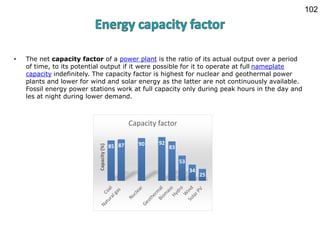All natural energy on Earth comes from solar radiation, heat from the Earth's mantle, and gravity. Fossil fuels like coal, oil, and natural gas are limited, non-renewable sources that have formed from ancient organic matter over millions of years. Energy can also be generated renewably from solar, wind, hydroelectric, geothermal, and biomass sources. Nuclear fission of uranium and thorium isotopes in the Earth's crust is another non-renewable source of energy. Hydrogen may become a sustainable energy source in the future.



![Fuel
kWh per
kilogram*
Deuterium–tritium 92 400 000
Uranium-235 23 279 200[3]
Hydrogen (compressed
at 70 MPa)
34
Natural gas 15.5
Gasoline (petrol) /
Diesel
~13
Propane (including LPG) 13
Biodiesel 12
Ethanol 8.4
Coal 6.7
Wood 5
Car battery (lead-acid) 0.7
Li-ion battery 0.24
Alkaline battery 0.67
Nickel-metal hydride
battery
0.288
106
Fuel kWh per m3
Liquid hydrogen 2389
Hydrogen, at 690
bar and 15°C
1260
Hydrogen, gas[ 2.8
Natural gas 10.2
Gasoline (petrol) /
Diesel 9600](https://image.slidesharecdn.com/energyproductionconsumption-140708084901-phpapp01/85/Energy-production-consumption-4-320.jpg)
![Electricity generation Efficiency
Gas turbine up to 40%
Gas turbine plus steam turbine
(combined cycle)
up to 60%
Hydropower turbine up to 90%
Wind turbine up to 59% (theoretical limit)
Solar cell 6–40% (technology dependent)
Hydrogen Fuel cell up to 85%
Geothermal power 10–23%
Engine/Motor
Combustion engine 10–50%[2]
Electric motors
70–99.99% (above 200W);
50–90% (between 10–200W);
Electrolysis of water 50–70%
Appliances
Incandescent light bulb 0.7–5 %
Electric heater 100 %
Natural process
Photosynthesis up to 6% [3]
Muscle 14–27%
Energy conversion efficiency is
the ratio between the useful
output of an energy conversion
machine and the input, in
energy terms. The useful
output may be electric power,
mechanical work, or heat.
103](https://image.slidesharecdn.com/energyproductionconsumption-140708084901-phpapp01/85/Energy-production-consumption-5-320.jpg)
![• Energy returned on energy invested (EROEI); or
energy return on investment (EROI), is the ratio of
the amount of usable energy acquired from a
particular energy resource to the amount of energy
expended to obtain that energy. Determining the
EROEI is often complex, resulting in wide variations in
the data. In the asesment the whole life cycle should
be envisaged.
• The more difficult to extract energy from a source, the
more energy is to be invested to extract it, lowering
the EROEI and increasing the price. For example, when
oil was originally discovered, it took on average one
barrel of oil to find, extract, and process about 100
barrels of oil. That ratio has declined steadily over the
last century to about three barrels gained for one
barrel used up in the U.S.
• If an energy source can flow to different tracks, its
EROEI will increase. For example in Europe rapeseed is
used to produce biodiesel. The EROEI is around 1.5
but a side product, pure plant oil, is used as a protein-
rich animal food, with an EROEI of 16.
105
Energy source ERoEI[1]
Crude oil (per
2007)
10
Oil sands (per
2007)
2 - 4
Natural gas 5 – 10
Coal 1 – 10
Nuclear 2,7 - 4
Hydroelectric 10
Wind 3 – 10
Solar panels 1 – 10
Biofuels
Soy biodiedel 5.5
Sugar cane ethanol 4 - 8
Rapeseed biodiesel 1,5
Corn ethanol 0,8 - 1,5
Maize ethanol 1,1
Biomass 0,8
Hydrogen 0,5](https://image.slidesharecdn.com/energyproductionconsumption-140708084901-phpapp01/85/Energy-production-consumption-6-320.jpg)












![113
The table underneath shows the number of people killed by electricity generation systems
worldwide per year, as collated by the IEA from different studies (lowest and highest numbers
are given). Coal is responsible for a much higher number of deaths than other energy
sources, while nuclear fatalities are lowest. In the Chernobyl disaster there were 56 direct
deaths and 4000 people died from cancer. Recent estimates on the hazards caused by the
Fukushima nuclear accident predict a total of 130 cancer deaths over lifespan.[22] Some 230
000 people were killed in a dam failure of a hydroelectric power station in China in 1975.
However, it is astonishing to note that the number of people killed in road accidents
worldwide was 1,230,000[2] in 2007.
It is even more astonishing that the annual death toll due to fossil energy-related
climate change is 400 000 and that this will increase to 700 000 by 2030 if a drastic
change in our fossil energy economy is not implemented.
Average number of people killed/year due to
electricity generation
Low estimates High estimates
Coal 2296 26814
Hydroelectric 320 512
Natural gas 126 672
Nuclear 52 312](https://image.slidesharecdn.com/energyproductionconsumption-140708084901-phpapp01/85/Energy-production-consumption-19-320.jpg)